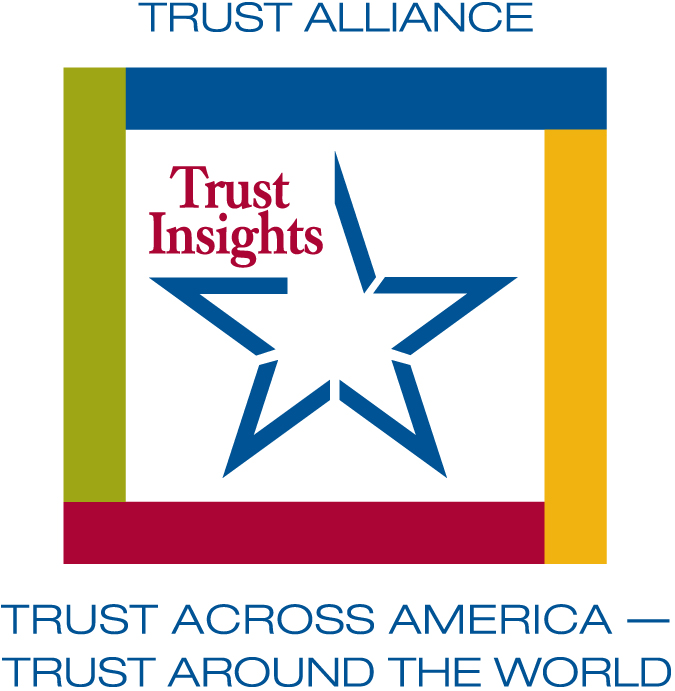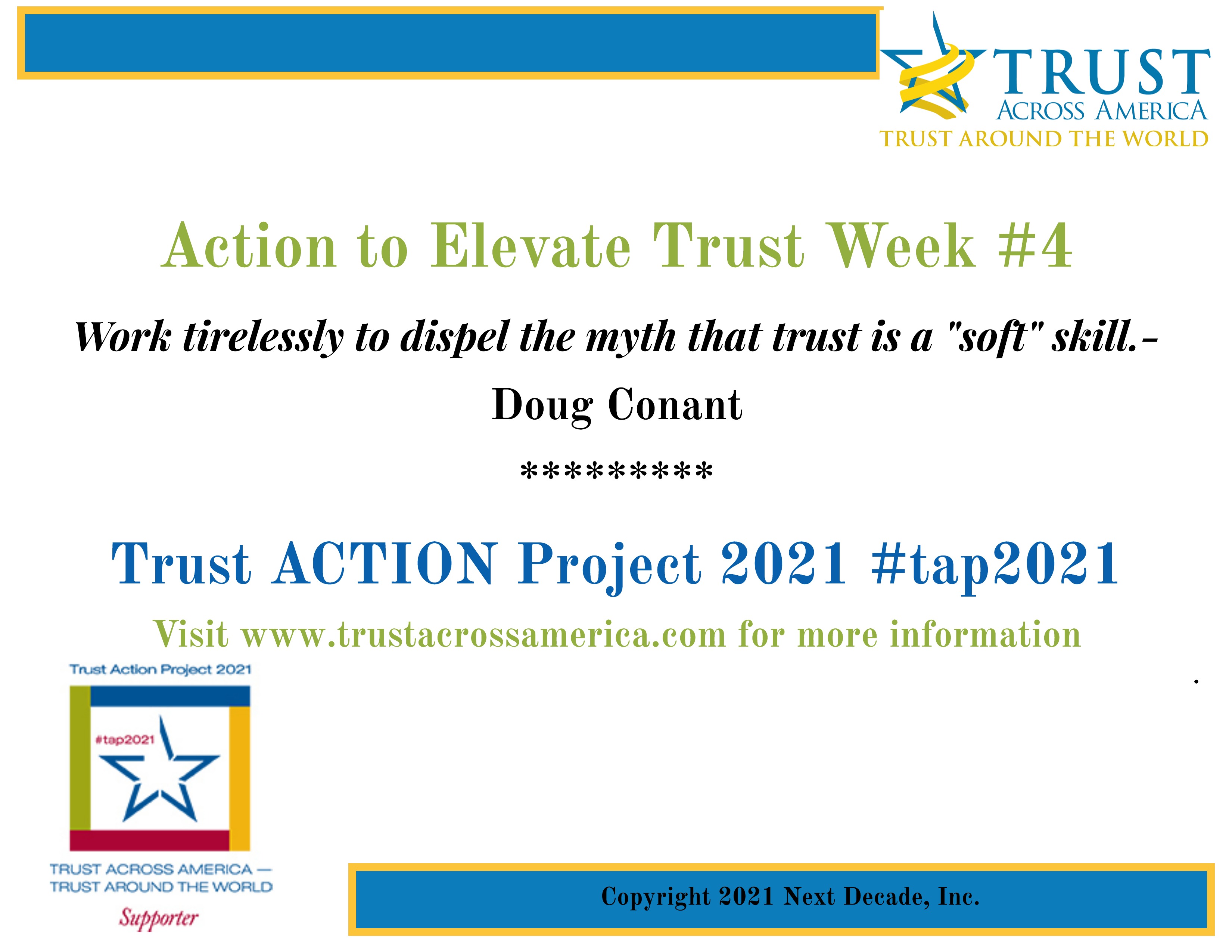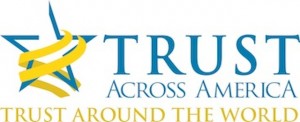 Doug, thank you for participating in our 2020 Trust Insights series. What is your trust insight?
Doug, thank you for participating in our 2020 Trust Insights series. What is your trust insight?
“Building trust doesn’t have to be overwhelming; trust starts with small actions that honor your commitment to others and grows larger and more powerful over time.” Doug Conant, ConantLeadership
Can you expand a bit on this important insight?
Many leaders are so beset by the deluge of competing priorities they face on any given day that the idea of creating space for building and maintaining trust is daunting. But the heartening truth is that trust—like anything else—can be built by taking small, manageable steps. Rather than feeling that you must embark on an enormous and momentous trust-building endeavor that could extend across the space of many months or years, you can start to bring trust to life in your leadership today by taking one small action in service to trust.
Remember: Behaviors are what make trust real. Focus on building micro-practices that honor your commitment to others into the way you lead; this allows you to create trustworthy teams and organizations while acknowledging the zany reality of busy, modern life. Each step you take towards trust can and should be in harmony with the pace and complexity of the modern enterprise. You don’t have to choose between honoring your commitments and cultivating trust. With a small-steps approach, you can do both.
Can you provide a real life example of a trust “challenge” where your insight has been effectively applied.
In 2001, on my first day as CEO of Campbell Soup Company, I arrived to a foreboding sight: a rundown building surrounded by razor wire with guard towers looming in the sky. The grounds were overgrown with weeds and the whole headquarters looked like a prison. Inside was just as bad: the paint was peeling and there were dead plants in the common areas. The drab tableau was a grim visual metaphor for the state of the company overall where market performance had been declining and employee engagement had become abysmally low. There was barely any trust left between the leadership and the employees. It was going to be an uphill battle to rebuild trust and advance performance. But I was determined to make an impact. I knew I couldn’t tackle it all at once; I had to start small.
The first micro-action I took was the simple act of listening, really listening to people. I started soliciting feedback right away. I discovered that many employees felt disrespected, even imprisoned, by their sub-par workplace environment. Some leaders might dismiss this as petty belly-aching. But they were right; the facilities needed help. And I saw a clear and compelling opportunity to start to build trust. Here was a way I could demonstrate that I valued the perceptions of our employees. Relative to other initiatives, it would be a low-investment endeavor that could earn me lots of goodwill.
Almost immediately, physical changes were made; we removed the razor wire, we cleared the overgrowth, we repainted the walls. These improvements quickly contributed to an increase in employee engagement. Performance got better. A virtuous circle began to form. As I heard people and took action in response to that listening, I earned trust, which led to better outcomes, which led to even more trust.
Building trust began with something as tiny and seemingly inconsequential as a fresh coat of paint. But it activated a cycle of continuous improvement across all of our operations and paved the way for more and better facility improvements. Over my decade-long tenure, these upgrades became symbols of my promise to listen to the people who worked there. Bettering the work environment and making people feel heard ultimately led to a modern reimagined world headquarters in Camden that everyone in the company could take pride in. The better facilities were a manifestation of trust-building in action. We started with very small actions like listening, pulling up weeds, and removing some razor wire; it might not seem like much, but these actions grew into something bigger which was inflected throughout all of our initiatives and our improved performance in the marketplace.
Little, incremental steps are the “walk” that demonstrate the “talk,” or language of trust. It’s a powerful lesson to learn. You don’t have to fix everything all at once. To start to build trust, just do something small. Do it earnestly, do it quickly, and you’ll begin to create a positive cycle of elevated trustworthiness and better outcomes.
Generally, do you think the global “trust” climate is improving or worsening? What actions are making it better or worse?
There is an undeniable dearth of trust globally. That said, I do think the global trust climate is modestly improving–at least in the business community (where the baseline is admittedly far too low to begin with). It’s easy to watch the news and feel discouraged—and it is important to have a clear-eyed view of the trust challenges we face as a whole—but it’s important to remember that good news seldom makes headlines.
While I do believe trust is modestly improving, we can’t rest on our laurels. Leaders must lead from in front on this issue, championing the importance of trust from the top, and modeling the behaviors that build trust–with diligence and passion.
Many claim we have a crisis of trust. Do you agree?
I don’t believe it is a crisis; however, it simply must get better. When we catastrophize, we let ourselves off the hook; people begin to feel the problem is so big that they absolve themselves of the responsibility of addressing it. This benefits no one. We must be both idealistic and realistic: we have to acknowledge that there is indeed a lack of trust in public institutions and in leadership while simultaneously working to be the change we want to see in the world at large. As leaders, it is our duty to show people the way. We have to rise to the occasion and stand up and be counted. Trust is paramount. Let’s show people how to build it one small action at a time.
Doug, how has your membership in our Trust Alliance benefitted you professionally?
As a leader, I always benefit from the learnings and insights from a community of my peers. The Trust Alliance helps me engage with a like-minded cadre of trust-focused leaders, buoys my dedication to continuous improvement, and empowers me to remain steadfast in my commitment to workplace trust.
Doug, thank you so much for your time and more importantly for your commitment to elevating organizational trust. What would you like our audience to know about you?
Doug Conant is an internationally renowned business leader and New York Times bestselling author with over 45 years of experience at world-class global companies. He is Founder of ConantLeadership, a boutique leadership firm committed to championing leadership that works in the 21st century. For the past 20 years of his leadership journey, Doug has honed his craft as a C-suite executive – first as President of the Nabisco Foods Company, then as CEO of Campbell Soup Company (2001-2011), and finally as Chairman of Avon Products. Doug’s new book, The Blueprint: 6 Powerful Steps to Lift Your Leadership to New Heights is now available wherever books are sold.
And while you are here, Tap Into Trust and complete our 1 minute/1 question quiz. Find out how the level of trust in your workplace compares to hundreds of others.
Have you reviewed how our workshops are helping teams and organizations just like yours to elevate trust?
Did you miss our previous 2020 insights? Access them at this link.
Contact us for more information on elevating trust on your team or in your organization or email me directly: barbara@trustacrossamerica.com
Copyright 2020, Next Decade, Inc.




Recent Comments